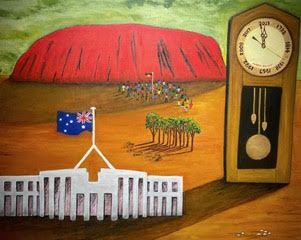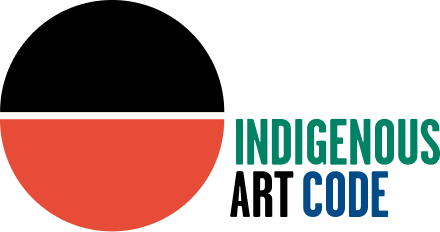Sandra Saunders is a visual artist with twenty-five years of practice and experience working in the Indigenous art sector.
What does fair mean to you? Interview with artist Sandra Saunders

A Ngarrindjeri/Buandig woman, Saunders is based in Wangary in South Australia, forty-five kilometres west of Port Lincoln. Working mainly in the medium of oil on canvas, Saunders art is about political issues and the history of this country.
“My inspiration comes from events that have happened which have an impact on Aboriginal people. For example, Invasion and stories from and about Hindmarsh Island”, said Ms Saunders.
When asked about her experiences in working as an artist and whether or not she’d encountered any unfair practices from within the industry, Saunders remarked saying she “does [her] own thing”. With such determination, Saunders has found she’s successfully navigated the art world and has enjoyed sustainability in showcasing her art and that she’s lucky enough to not have experienced any direct unfairness.
“I have, in recent years, received lots of support from Country Arts”, said Ms Saunders, “I think there is a lot of support and follow-up from workers in the Indigenous arts sector”.
However, she remains vigilant in saying that should she ever experience any unfair practices, that Saunders will “just call it out”, emphasising the importance of artists being mindful of their rights.
“Do your own thing, ask for help if in need, find out who is around to support you, for example the Indigenous Art Code or any Arts Officers etc. in your area”, recommends Saunders.
“I associate the idea of ‘fair’ with the values of Equity, Impartiality and Equality—these words all convey the idea of treating everyone equally and without bias”, said Sandra Saunders in closing.

_________________________
Indigenous Art Code asks Code Signatories (Code Signatories) to work fairly and transparently with artists, and the Indigenous Art Code of Conduct (the Code) sets out guidelines for Code Signatories to do this.
But from the artist’s perspective, what is fair?
Following conversations with Waanji, Teppathiggi and Tjungundji artist, writer, activist and deep thinker, Jack Wilkie-Jans, Indigenous Art Code commissioned him to write something about the concept of ‘fair’ from the artist’s perspective. In this series of interviews, Jack speaks with a diverse group of First Nations artists and cultural practitioners from across the country to better understand what fair means to them when they are creating art that is to be sold or licensed.

Jack Wilkie-Jans (Waanji, Teppathiggi and Tjungundji man of British, Vanuatuan and Danish heritage) is an established arts writer, artist, arts worker, and Aboriginal affairs advocate from Cape York Peninsula, based in Cairns/Gimuy, Queensland. After 12 years working across the contemporary Indigenous visual arts sector (at all levels of project management, domestically and internationally), in 2023 Jack launched his own consultancy practice: JWJ Consultancy. Professionally, Jack specialises in arts writing & review; policy guidance; governance and operational best Cultural practice; artist representation; regional economic development; and land management.
A Tribal Great-Grandson of Dr Thancoupie/Thanakupi Gloria Fletcher James AO, Jack is an Alumni of the National Gallery Leadership Program (2011). As an artist (painting, film and photography) his focus is on post-colonial narratives and non-Culturally specific artistic abstraction and exploration.

